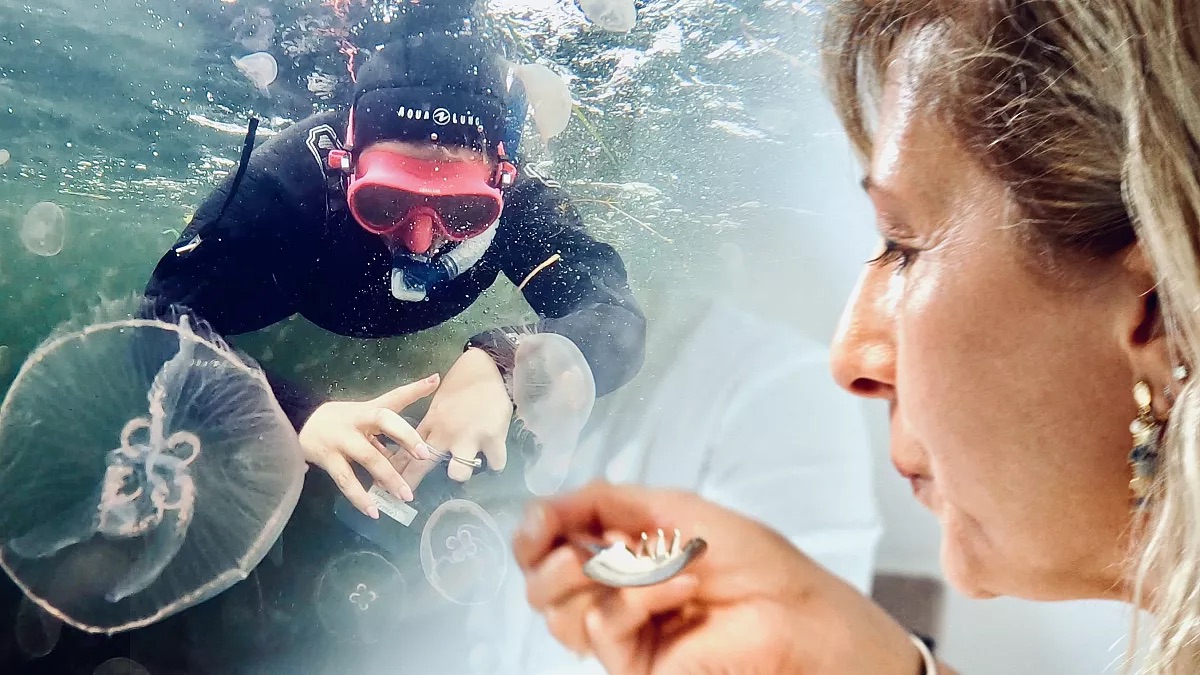Kerteminde is a charming harbour town in Central Denmark with a stunning fjord surrounded by fields, hills, and forests.
It’s a haven for marine wildlife, but scientists from the University of Southern Denmark (SDU) are intrigued by one mysterious species – jellyfish.
The species is booming just beneath the surface of the water, where this group of scientists jump into. In their snorkelling dive, they observe the jellyfish and collect samples.
These sea jellies aren’t very stingy, but their biomass here is so dense it harms other species.
Massive jellyfish blooms
Around the world, jellyfish sting tourists, clog fishing nets, and block water pipelines.
There are even fears that they might replace all other sea species.
But Jamileh Javidpour, who has been studying jellyfish for over 20 years, says we don’t know enough yet to make such predictions.
“Apocalyptic scenarios of jellyfish bloom are existing, and there are partly true stories because the presence of jellyfish might affect the entire ecosystem,” explains Jamileh Javidpour, associate professor at SDU.
“However, changes in the entire population need a kind of holistic view — what is the effect of other populations that are connected to this player of the food web together? So we need a kind of adaptive view to jellyfish bloom, which is still not existing.”
Back on the boat, scientists sample water characteristics and use a dip net to collect more jellyfish samples.
Researchers monitored water temperatures, salinity, and other factors to better understand the causes of jellyfish blooms.
Thriving amid overfishing
It appears jellyfish thrive due to overfishing, which removes their predators and competitors, and agricultural runoff that depletes oxygen in the water.
Unlike other species, jellyfish aren’t bothered by low oxygen levels.
While jellyfish blooms can be problematic, researchers believe a sustainable use for this gelatinous plankton can be found.
For instance, jellyfish could provide an alternative source of collagen for cosmetics. They are also great at capturing microplastic particles, which can help clean the oceans.
Jamileh Javidpour coordinated the GoJelly project, funded by the European Union. The project came up with a method to use jellyfish mucus, either natural or synthetic, to filter wastewater before it reaches the ocean.
“They take up particles very actively, capture these particles, and pack them in a biological mucus filter to get rid of them,” says Javidpour.
“And that is a pattern that we can learn from nature to come up with natural solutions.”
Possible uses for sea jellies are numerous
In Italy’s southern Apulia region, researchers at the Institute of Sciences of Food Production in Lecce are experimenting with turning jellyfish into plant fertiliser.
They start with frozen sea jellies and use vacuum drying to convert them into white powder.
Besides salts, this powder contains valuable amino acids, minerals and other nutrients present in jellyfish that can be readily absorbed by plants.
Experiments show that plants grow better on jellyfish nutrients compared to a substrate with just salts.
According to Stefania De Domenico, Functional food researcher, CNR-ISPA, there is a clear difference in plant growth.
“This one is more lush, compared to the control sample, which has the same concentration of salts, but plants there are much more stressed and therefore drier.”
Experiments with human cancer cells
Jellyfish could even help cure diseases.
Although still in the very early stages of research, scientists have discovered bioactive compounds in jellyfish that can trigger the death of breast cancer cells in experimental conditions.
“The extracts of these jellyfish have anti-proliferative activity on human cell cultures. We have observed that they can reduce the proliferation of cancerous cells while having no effect on non-cancerous cells,” says Antonella Leone, a senior researcher, at CNR-ISPA.
Preparing fish soup with jellyfish
And since jellyfish often end up in fishing nets, why not eat them? In Asia, this is common practice.
This restaurant in Lecce is part of a European project exploring jellyfish as food. Chef Fabiano Viva believes seafood lovers will enjoy cooked jellyfish with its intense marine flavour.
“Jellyfish are often not well-regarded because they can sting and hurt you”,- says Fabiano Viva. “People think they might also be harmful to eat. Let’s debunk this myth: [some] jellyfish are not harmful at all. In fact, they are simply delicious!”
The recipe features jellyfish in a traditional Mediterranean seafood soup, but chefs see many other possible ways to cook jellyfish.
“This one can be sliced and added to a salad, for example. With this one, you can do almost anything—you can put it in a soup, as we did today, or even roast it”,- explains Viva.
Researchers, led by Antonella Leone, have developed a safe method to preserve jellyfish without using the aluminum salts that are common in Asia, but considered harmful in Europe.
Instead, they propose using calcium salts, which are safe to eat and preserve the jellyfish’s texture better.
The researchers teamed up with chefs to make a cookbook with jellyfish recipes. But before jellyfish can be served to the public, they need to be officially approved as food.
“What is required is authorisation from the European Food Safety Authority to ensure we provide a safe product to consumers. Additionally, we must carefully study the entire process, from fishing to preparation, to ensure it is safe and sustainable.”
Sustainability is key
While jellyfish blooms are increasing in seas like the Mediterranean, researchers caution against large-scale fishing of these diverse species.
According to Dr. Leone, there is still a lack of knowledge about these gelatinous creatures and their unique life cycles.
However, surveys and samplings are ongoing in the seas around the planet.
In the meantime, any jellyfish-derived compounds used by the industry could be synthesised or based on sustainable production methods such as jellyfish aquaculture.
Removing too many jellyfish from our oceans before fully understanding them could put their ecosystem on a slippery slope, potentially causing more harm than good to the marine environment.
“I hope we can continue to study these organisms in depth in their natural environment. If there is a possibility of using any compound that may be useful to humans, it must be done in a sustainable way.” says Dr. Leone.
Several experts agree that the best way to keep marine life healthy is to address the root causes of their problems, such as climate change, pollution, and overfishing.
And since jellyfish have been a part of marine ecosystems for the last 500 million years, with proper balance, they will keep their rightful place in our oceans’ natural harmony.





